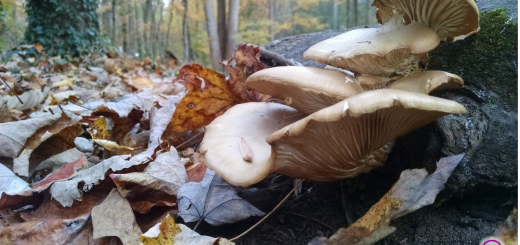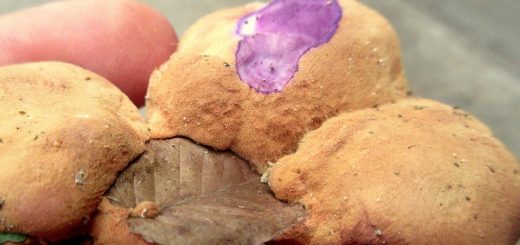#100: Uncommon Mushroom Toxins
In addition to the eight common types of mushroom toxins, mushrooms produce a number of other compounds that are toxic to humans. The North American Mycological Association lists eight of these less common toxins/syndromes. Many of these are limited to a few, closely-related species and are therefore not as frequently observed as the eight types described previously.
Amanita Kidney Failure
There are three Amanita species known to cause kidney failure: Amanita smithiana, A. proxima, and A. pseudoporphyria. Scattered reports indicate that various other mushrooms in the Amanita section Lepidella also have this ability. Renal failure can also occur after eating amanitas that contain amatoxins, but this only happens after liver function is severely impaired. The fact that A. smithiana and other Lepidella species cause kidney failure without damaging the liver sets them apart from the majority of Amanitas. The toxin orellanine also causes renal failure, but that compound does not produce symptoms as rapidly as the amanitas in question and is only found in mushrooms of the Cortinarius genus. Amanita kidney failure is presumed to be caused by the toxin allenic norleucine (an amino acid that cannot be used in proteins), but this is still up for debate. Symptoms of this type of poisoning begin between four and eleven hours after ingestion and include: gastrointestinal (GI) irritation, cramps, chills, disorientation, anxiety, and kidney failure. These symptoms are sometimes accompanied by a generally sick feeling, warm feeling, weakness, sweating, thirst, and the production of abnormally small or large amounts of urine. Treatment focuses on alleviation of symptoms and often involves hemodialysis for a time. With this treatment, patients usually recover.
Acute Autoimmune Hemolytic Anemia
This condition is the result of long-term consumption of mushrooms in the Paxillus involvutus complex. Although P. involvutus and its close relatives are edible in the short term, mycologists now recommend avoiding the mushrooms altogether due the problems they cause in the long term. Immune hemolytic anemia can appear suddenly in people who have eaten P. involvutus for years without any problems. Some as yet unidentified toxin in the mushroom makes a patient’s white blood cells produce antibodies against her/his own red blood cells. This results in the destruction of the red blood cells, which causes symptoms of anemia. These symptoms include: feeling tired/weak, difficulty concentrating, headaches, pale skin, shortness of breath, light-headedness upon standing up, a blue tinge to the whites of the eyes, brittle nails, and a sore tongue. Because this is an autoimmune disease, it is difficult to treat. Treatment options include: corticosteroids, removing the spleen (in which many red blood cells get destroyed), immunosuppressants, and blood transfusions.
Alcohol-Induced GI Irritation
These symptoms can be caused by a number of mushrooms, including a few edibles such as: Oyster Mushrooms (Pleurotus ostreatus), Morels (Morchella spp.), Honey Mushrooms (Armillaria mella), and the Penny Bun (Boletus edulis). In some susceptible people, these mushrooms can cause GI irritation (nausea, diarrhea, vomiting, cramps, etc.) only if alcohol is consumed shortly after the mushrooms. Unlike coprine (which also causes symptoms in combination with alcohol), there is NO racing heart, flushing, warmth, etc. Most people can eat these mushrooms without any problems (even with alcohol), so they are still considered edible.
Rhabdomyolysis
Two mushrooms are known to cause these symptoms: Tricholoma equestre and Russula subnigricans. Although the former occurs in North America, symptoms have only been reported from mushrooms collected in Europe. The latter is only found in Japan and Taiwan, so North American mushroom hunters do not need to worry about these toxins. T. equestre and R. subnigricans have different toxins that cause symptoms using different mechanisms, but they both result in rhabdomyolysis. This disease is characterized by a breakdown of muscle cells, which releases the contents of those cells into the blood stream. These contents include myoglobin, which clogs up the kidneys and thereby destroys kidney function. If left untreated, the condition is likely to result in death. In Europe, rhabdomyolysis is often accompanied by respiratory problems and an enlargement of the heart muscle, both of which can also lead to death. Initial symptoms of rhabdomyolysis include: muscle pain, weakness, bruising, tenderness, and swelling. As the disease progresses, it causes: tea-colored urine (which is one of the major indicators of the disease), fever, nausea, vomiting, generally sick feeling, agitation, confusion, delirium, and no output of urine (which indicates kidney failure). Treatment focuses on helping the kidneys function properly. This is initially done by making sure the patient remains well hydrated. If symptoms continue to worsen, hemodialysis may be required.
Erythromelalgia
This condition is primarily caused by Clitocybe amoenolens and C. acromelalgia. Other mushrooms that may cause these symptoms include: C. inversa, C. squamosa, C. gibba, and Hygrophoropsis aurantiaca (FFF#196). These mushrooms cause excess blood to be diverted to the extremities (especially the fingers, toes, and nose), which results in the extremities becoming bright red, painful, and warm to the touch. Symptoms appear about one week after ingestion and can last for several months. This condition is presumably caused by acromelic acids, which are structurally similar to the neurotransmitter glutamic acid. A variety of drugs can treat the condition, but not all drugs work for every person. Commonly used drugs include pain medications, anticonvulsants, and antidepressants. Cooling down the extremities is also effective at relieving symptoms.
[Side Note: if you can figure out how these mushrooms cause erythromelalgia, you may be able to develop a drug to treat the condition in patients who have not eaten those mushrooms. For example, you may be able to modify one of the mushroom compounds to prevent activation of its target receptor (perhaps through competitive inhibition), thereby turning off the disease.]
Encephalopathy
The mushrooms Hapalopilus rutilans and Pleurocybella porrigens contain toxins that can cause brain damage and impair kidney function. In the former, the toxic compound is polyporic acid, while the latter’s toxicity is probably due to the highly unstable compound pleurocybellaziridine and its amino acid derivatives. These compounds are structurally unrelated, so they presumably cause the same symptoms using different mechanisms. Polyporic acid is the only poison that I know of that can be found in polypores. Although a variety of polypores have been shown to contain polyporic acid, poisonings have only been reported after consuming H. rutilans and H. nidulans (which may be synonymous). P. porrigens is regularly eaten in Japan without any problems, except in 2004. During that year, an exceptional crop of P. porrigens was produced and consumed, resulting in the deaths of 17 people. All of these people already had impaired kidney function, so it seems likely that healthy kidneys can effectively remove the toxins. Both mushrooms cause seizures, brain damage, and kidney damage. Poisonings like this are rare, so there is not yet an established course of treatment.
Rash
I have said before that all mushrooms are safe to handle, and that is true for most people. However, some individuals may experience a poison ivy-like rash after touching certain mushrooms due to personal sensitivities. The offending mushrooms are usually Suillus species, particularly S. amaricanus and its relatives. Treat this as you would a normal skin rash and wear gloves the next time you pick that mushroom.
Shiitake Dermatitis Syndrome
Raw or undercooked shiitake mushrooms (Lentinula edodes) can cause a rash in susceptible individuals (less than 2% of the population). The rash is not an allergic reaction, but rather is caused by the toxin lentinan. Lentinan is a polysaccharide that structurally resembles starch. When a susceptible individual touches L. edodes, lentinan gets on the skin and causes blood vessels just under the skin to dilate. This releases inflammatory compounds into the skin, much like what happens during an allergic reaction. However, since the immune system is not involved in this reaction, the rash neither itches nor hurts at the outset. The rash first appears as a red area, which soon forms blisters. The blisters harden over and become raised, purple welts, which last for a few days. People who eat large amounts of raw shiitake may develop an allergic reaction to compounds in the fungus. The offending compounds (including lentinan) are destroyed by cooking, so you should always cook your shiitakes (and every mushroom, actually).
Other Mycotoxins
Toxic compounds are produced by many fungi, not just mushroom-forming ones. Some of these toxins are beneficial (for example, penicillin), while others are harmful. Don’t eat moldy bread because you never know what mycotoxins the fungus has secreted. I will eventually get around to discussing some of the more interesting mycotoxins, so keep up with Fungus Fact Friday if you would like to learn more about this topic!
See Further:
http://www.namyco.org/mushroom_poisoning_syndromes.php
http://ndt.oxfordjournals.org/content/early/2011/09/29/ndt.gfr511.full
http://www.merckmanuals.com/home/blood-disorders/anemia/autoimmune-hemolytic-anemia
http://www.mykoweb.com/CAF/species/Paxillus_involutus.html
http://www.aafp.org/afp/2002/0301/p907.html
http://www.erythromelalgia.org/WhatisEM.aspx

![#007: Omphalotus illudens, the Jack-O-Lantern Mushroom [Archived]](https://www.fungusfactfriday.com/wp-content/themes/hueman/assets/front/img/thumb-medium-empty.png)







![#011: Characteristics of Kingdom Fungi [Archived]](https://www.fungusfactfriday.com/wp-content/themes/hueman/assets/front/img/thumb-small-empty.png)
